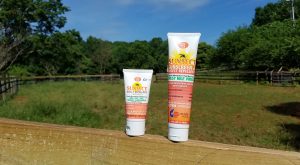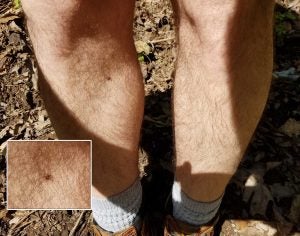For all the hours I spend outside each week, I’ll admit that I’m pretty bad when it comes to using sunscreen. The greasiness that so many sunscreens leave on my hands makes it hard (or even dangerous) to grip a power drill or hang onto a lunge line while I’m working my horses.
Yet there’s more to it than that. Since last fall, I’ve become obsessive about using insect repellent. That’s when I was diagnosed with the alpha-gal allergy, which took hold after I was bitten by a Lone Star tick. It has completely changed what kind of person I am and how I approach rural life. When I eat any meat that comes from a mammal or consume any dairy, I get headaches, rashes, and shortness of breath, among other symptoms. Another bite from an infected tick can amplify the allergy, so insect repellent is my priority, and research has shown that many brands of sunscreens and insect repellents don’t play well together.
Because of all this, I couldn’t have been more excited to get to try out Sunsect on my little farm. As the name suggests, this product is made to ward off the sun‘s rays as well as insects. Sunsect was originally developed for military use (meaning it’s been put to use in some rough environments all over the world) and has only been marketed publicly since the summer of 2017.
“The military wanted something that they could give a soldier, where if he’s in the jungles of Panama, he has insect repellent, but if he has to go to the beach for an extraction, he’d have sunscreen and that the sand wouldn’t stick to him,” Steve Shafer, CEO of Florida-based Sunsect, told me.
The DEET-backed liquid has an SPF of 15 and helps protect against critters carrying Lyme disease, Denge fever, West Nile virus, Zika, and so many others. It’s already fairly popular with anglers who would otherwise spend long-hours swatting at mosquitoes and other flying insects.

On my land, there’s a mix of woods, mowed areas, and long grass. My biggest concern right now is my kids — ages 6 and 4. This area of Virginia is loaded with ticks, and my kids are loaded with curiosity and adventure. No matter what kind of ticks are out there — the American dog tick, deer tick, and Lone Star tick are among the most common — I worry about the effects bites can have.
My wife and kids were the first to try out Sunsect — my wife, especially, has very sensitive skin and has been to an allergist multiple times after exposure to plant oils outdoors or to ingredients in a variety of brand-name lotions and body washes (even “natural” products often cause problems for her). To her surprise — and relief! — she had no adverse reactions to Sunsect. It’s a testimonial that Shafer has heard time and time again from other customers.
Shafer said he has the patent on the use of DEET in a sunscreen/insect repellent combination, so this is the only product of its kind available. Sunsect has 20 percent DEET, but because of how it interacts with the sunscreen, it evaporates more slowly than typical DEET products — this means that Sunsect at just that 20 percent is effective a lot longer than other products with the same percentage of DEET.
“The DEET actually sits suspended in the sunscreen and slows the evaporation down,” he said. It also doesn’t leave a sticky residue once it dries on your skin.
After my wife gave the product a thumbs-up and my kids had no complaints whatsoever, it was finally my turn to try it. I readily decided to put it to the test in a big way. Part of my property is being cleared by the power company, making the stretch a hotbed of tick activity.

I could imagine the ticks walking across my skin even before I stepped foot into this mess. It’s rare for me to go outside and not find a tick on me, especially if I’ve forgotten to use some kind of repellent. My Sunsect test was this: apply the product to one leg, and leave the other leg untreated. I don’t enjoy picking ticks off of me, but this was going to be the most honest and fair way to approach it.
Within just a few minutes, I picked three ticks off of my untreated leg. They were fast-moving little buggers, but I was paying close attention, and none paused long enough to actually start biting.
On the leg that had the Sunsect on it? There wasn’t a tick to be seen. Zero, zilch, nada. In fact, after two weeks of using Sunsect consistently around my property, I have yet to suffer an insect or arachnid bite.

There’s little question that I’ll be using this all year around the farm or when I’m in the woods. I’ve already added a few more tubes to my Amazon shopping cart (they’re available in 2- and 4-ounce tubes, as well as in single-use packets). This year, the company plans to roll out an SPF 30 version. It is also testing and formulating a spray version and a stick (like a deodorant stick), which are likely to be unveiled in 2019.
Sunsect has an active Instagram page, where you can see exactly where people take their Sunsect and in what ways folks get outdoors. For me, it’s all about the farm and getting to spend more time with my horses and goats or tending to my garlic, worry-free from bites and burns.
This product review was published on behalf of Sunsect.



